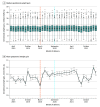Trends in Gestational Weight Gain in Louisiana, March 2019 to March 2022
- PMID: 37642960
- PMCID: PMC10466167
- DOI: 10.1001/jamanetworkopen.2023.31277
Trends in Gestational Weight Gain in Louisiana, March 2019 to March 2022
Abstract
Importance: Average gestational weight gain (GWG) increased during the COVID-19 pandemic, but it is not known whether this trend has continued.
Objective: To examine patterns of GWG during the COVID-19 pandemic by delivery and conception timing through the second year of the pandemic.
Design, setting, and participants: This cohort study is a retrospective review of birth certificate and delivery records from 2019 to 2022. Electronic health records were from the largest delivery hospital in Louisiana. Participants included all individuals giving birth from March 2019 to March 2022. Data analysis was performed from October 2022 to July 2023.
Exposure: Delivery date (cross-sectionally) and conception before the pandemic (March 2019 to March 2020) and during the peak pandemic (March 2020 to March 2021) and late pandemic (March 2021 to March 2022).
Main outcomes and measures: The primary outcome was GWG (total GWG and adherence to the 2009 Institute of Medicine recommendations) analyzed using linear and log-linear regression with control for covariates.
Results: Among 23 012 total deliveries (8763 Black individuals [38.1%]; 11 774 White individuals [51.2%]; mean [SD] maternal age, 28.9 [5.6] years), 3182 individuals (42.0%) exceeded the recommended weight gain in the year proceeding the pandemic, 3400 (45.4%) exceeded recommendations during the peak pandemic, and 3273 (44.0%) exceeded recommendations in the late pandemic. Compared with those who delivered before the pandemic (reference), participants had higher total GWG if they delivered peak or late pandemic (adjusted β [SE], 0.38 [0.12] kg vs 0.19 [0.12] kg; P = .007). When cohorts were defined by conception date, participants who conceived before the pandemic but delivered after the pandemic started had higher GWG compared with those whose entire pregnancy occurred before the pandemic (adjusted β [SE], 0.51 [0.16] kg). GWG was lower in the pregnancies conceived after the pandemic started and the late pandemic (adjusted β [SE], 0.29 [0.12] kg vs 0.003 [0.14] kg; P = .003) but these participants began pregnancy at a slightly higher weight. Examining mean GWG month by month suggested a small decrease for March 2020, followed by increased mean GWG for the following year. Individuals with 2 pregnancies (1289 individuals) were less likely to gain weight above the recommended guidelines compared with their prepandemic pregnancy, but this association was attenuated after adjustment.
Conclusions and relevance: In this cohort, individuals with critical time points of their pregnancy during the COVID-19 pandemic gained more weight compared with the previous year. The increased GWG leveled off as the pandemic progressed but individuals were slightly heavier beginning pregnancy.
Conflict of interest statement
Figures

Similar articles
-
Racial disparities in gestational weight gain and adverse pregnancy outcomes among Black and White pregnant people with obesity.Obesity (Silver Spring). 2025 Feb;33(2):395-404. doi: 10.1002/oby.24206. Epub 2024 Dec 25. Obesity (Silver Spring). 2025. PMID: 39721796 Free PMC article.
-
Effect of Lockdown Period of COVID-19 Pandemic on Maternal Weight Gain, Gestational Diabetes, and Newborn Birth Weight.Am J Perinatol. 2024 May;41(S 01):e584-e593. doi: 10.1055/a-1925-1347. Epub 2022 Aug 16. Am J Perinatol. 2024. PMID: 35973792 Free PMC article.
-
Association of COVID-19 pandemic societal closures with gestational weight gain among women in South Carolina, 2018-2021.Ann Epidemiol. 2024 Mar;91:51-57. doi: 10.1016/j.annepidem.2024.02.002. Epub 2024 Feb 6. Ann Epidemiol. 2024. PMID: 38331235 Free PMC article.
-
Counseling and Behavioral Interventions for Healthy Weight and Weight Gain in Pregnancy: Evidence Report and Systematic Review for the US Preventive Services Task Force.JAMA. 2021 May 25;325(20):2094-2109. doi: 10.1001/jama.2021.4230. JAMA. 2021. PMID: 34032824
-
Association between gestational weight gain and perinatal outcomes among twin gestations based on the 2009 Institute of Medicine (IOM) guidelines: a systematic review.J Matern Fetal Neonatal Med. 2022 Dec;35(25):6527-6541. doi: 10.1080/14767058.2021.1918083. Epub 2021 May 27. J Matern Fetal Neonatal Med. 2022. PMID: 34044741
Cited by
-
Impact of Maternal Hyperglycemic and Hypertensive Disorders on Perinatal Outcomes Across the COVID-19 Pandemic.Womens Health Rep (New Rochelle). 2025 Apr 28;6(1):504-514. doi: 10.1089/whr.2025.0019. eCollection 2025. Womens Health Rep (New Rochelle). 2025. PMID: 40538669 Free PMC article.
-
Trends in adverse pregnancy outcomes in Louisiana, 2017 to 2022.Sci Rep. 2025 Mar 21;15(1):9704. doi: 10.1038/s41598-025-94092-0. Sci Rep. 2025. PMID: 40113946 Free PMC article.
-
Predictors of gestational weight gain in western India: Findings from a longitudinal study across rural and urban cohorts.PLoS One. 2025 Jul 28;20(7):e0328081. doi: 10.1371/journal.pone.0328081. eCollection 2025. PLoS One. 2025. PMID: 40720412 Free PMC article.
References
Publication types
MeSH terms
Grants and funding
LinkOut - more resources
Full Text Sources
Medical

